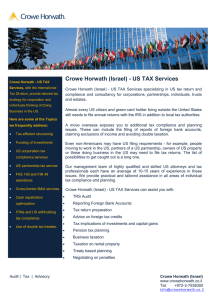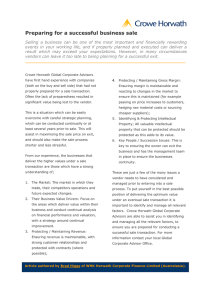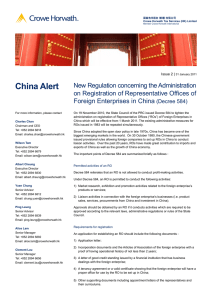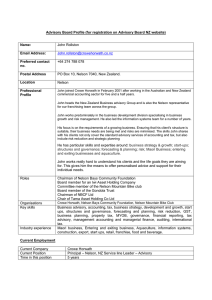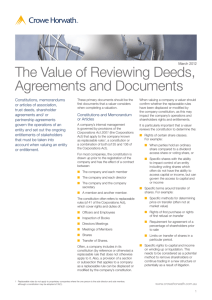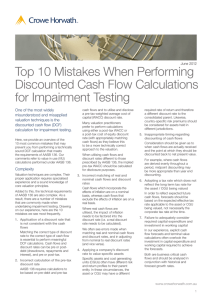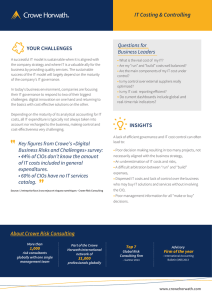The Global Corporate Advisor The Corporate Finance newsletter of Crowe Horwath International
advertisement
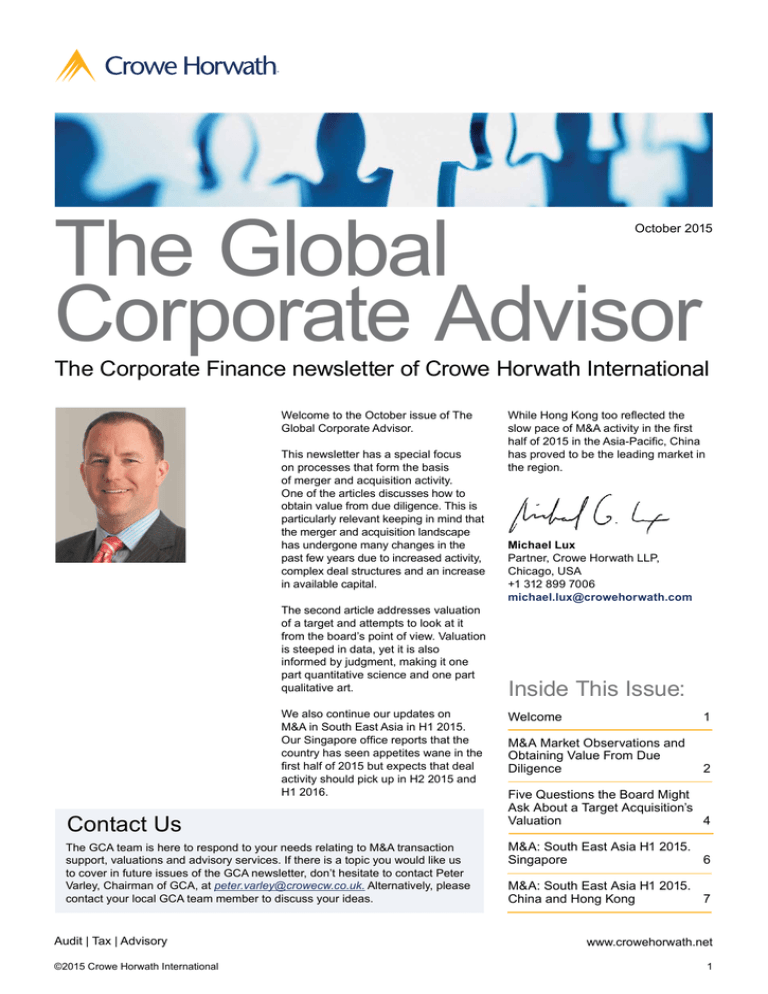
® The Global Corporate Advisor October 2015 The Corporate Finance newsletter of Crowe Horwath International Welcome to the October issue of The Global Corporate Advisor. This newsletter has a special focus on processes that form the basis of merger and acquisition activity. One of the articles discusses how to obtain value from due diligence. This is particularly relevant keeping in mind that the merger and acquisition landscape has undergone many changes in the past few years due to increased activity, complex deal structures and an increase in available capital. The second article addresses valuation of a target and attempts to look at it from the board’s point of view. Valuation is steeped in data, yet it is also informed by judgment, making it one part quantitative science and one part qualitative art. We also continue our updates on M&A in South East Asia in H1 2015. Our Singapore office reports that the country has seen appetites wane in the first half of 2015 but expects that deal activity should pick up in H2 2015 and H1 2016. Contact Us The GCA team is here to respond to your needs relating to M&A transaction support, valuations and advisory services. If there is a topic you would like us to cover in future issues of the GCA newsletter, don’t hesitate to contact Peter Varley, Chairman of GCA, at peter.varley@crowecw.co.uk. Alternatively, please contact your local GCA team member to discuss your ideas. Audit | Tax | Advisory ©2015 Crowe Horwath International While Hong Kong too reflected the slow pace of M&A activity in the first half of 2015 in the Asia-Pacific, China has proved to be the leading market in the region. Michael Lux Partner, Crowe Horwath LLP, Chicago, USA +1 312 899 7006 michael.lux@crowehorwath.com Inside This Issue: Welcome 1 M&A Market Observations and Obtaining Value From Due Diligence2 Five Questions the Board Might Ask About a Target Acquisition’s Valuation 4 M&A: South East Asia H1 2015. Singapore 6 M&A: South East Asia H1 2015. China and Hong Kong 7 www.crowehorwath.net 1 October 2015 ® M&A Market Observations and Obtaining Value from Due Diligence Jay Chung, Los Angeles, and Bart Kelly, Atlanta This article is based on the observations of Crowe Horwath due diligence specialists on the robust M&A market, and on our survey, Critical Pillars for M&A Success. In a question-answer format, we aim to offer insights and perspectives to help both corporate and private equity buyers assess whether target acquisitions are capable of realizing financial and operational value. Do those changes affect how buyers should approach deals? Has the M&A landscape changed in the past few years? In the Crowe Critical Pillars for M&A Success survey, more than 25% of respondents indicated that insufficient due diligence had the greatest negative impact on synergy capture. Several changes to the M&A landscape are worth noting. First, the number of buyers seeking acquisition targets is increasing, and this increased competition from buyers is driving up multiples. Second, deal structures are becoming more complex. Bank executives are eager to put their banks’ money to work, and some are writing no-covenant or covenant-light loans for the most credit-worthy borrowers. Managers are closing with all-cash transactions for high-profile deals with confidence that the balance sheets can be recapitalized later. However, even as deals become more complex, the majority of them are executed without relying on the right M&A playbook with strategies and processes in place to facilitate successful execution. Third, an increase in available capital is driving up valuations. Even with the amount of private equity capital available for investment, corporate balance sheets are more cash-rich than they were before the downturn. There was an uptick in the number of initial public offerings in 2014, evidenced by the increase in exit activity for both private equity and corporate institutional holders. Most industry sectors are challenged by the lack of organic growth, which leaves them with little choice but to incorporate an acquisition strategy to meet the objectives of partners and board members. Absolutely. In today’s M&A environment, buyers need to create a thorough due diligence plan that includes financial, operational and IT value drivers. Lacking a plan can significantly increase the risk that a deal won’t deliver expected value. Due diligence not only helps buyers anticipate the risks that can derail mergers but helps set the stage to capture targeted value. Are there strategies that buyers can use to increase the likelihood that they will achieve value from deals? Every deal is unique and has its own value drivers. However, in working with buyers in a wide variety of M&A transactions, we have identified three characteristics that consistently improve deal value: 1. Assigning adequate resources In the past, organizations had large, dedicated M&A teams, whereas today’s organizations often are stretched thin. More than a third (39%) of respondents in our survey said they did not have adequate resources for M&A deals. Our experience indicates that the percentage might be much higher. The most successful buyers rethink their resource allocation strategies and verify they are dedicating enough resources to deals. In many cases, these buyers rely on outsourcing and bringing in external expertise to complete and integrate deals. 2. Paying rigorous attention to all stages of the deal lifecycle Many strategic buyers apply a great deal of rigor to deal creation but neglect to consider the amount of effort a transaction adds to the workload of a staff that already is stretched thin. Existing staff members and managers are responsible for M&A activities in addition to normal responsibilities. These employees often don’t possess the necessary expertise and skills to execute a deal. For most of these employees, identifying synergy opportunities and then achieving those synergies are not core competencies. As a result, though pro forma assumptions and add-backs are validated, the integration’s actual execution falls short. In fact, 68% of respondents to our survey said maintaining momentum over the course of deals was a challenge. The most successful buyers are able to maintain focus throughout a deal, from creation to closing. The value of a transaction can be enhanced – or diminished – during any stage of the deal’s lifecycle. 3. Focusing on the full range of deal drivers Although financial arbitrage and aggressive underwriting are priorities in many transactions, they shouldn’t be the only drivers of deal value. We’ve found that buyers in the most successful transactions focus on additional deal drivers such as people and cultural risks. Consider the following findings from our survey: Audit | Tax | Advisory ©2015 Crowe Horwath International www.crowehorwath.net Discounted Cash Flows 2 October 2015 ® ■ 54% of respondents admitted they ■ Less than half (49%) of respondents Successful execution also requires holding decision-makers accountable for aspects of the deal, including operating synergies, executing on schedule, sales, and cost reduction. ■ More than 37% of respondents did How can outside specialists help organizations improve the likelihood of executing transactions that meet their financial and operational goals? did a poor or average job of identifying people and cultural risks. said they did a good or excellent job of clearly defining the potential risks that could cause a transaction to stumble or sink. not believe they did a good or excellent job of clearly defining deals’ value drivers. Instead of focusing solely on financial considerations, it’s imperative to also pay close attention to operational execution and challenges in actually integrating the businesses, including people and cultural risks. Working with a third-party professional can help a buyer protect and maximize an acquisition’s value. The benefits of external expertise include: ■ Assessing the transaction’s after-tax implications ■ Helping set realistic expectations ■ Prioritizing risk ■ Evaluating the cost of transitioning ■ Implementing effective performance measurement in areas in addition to finance ■ Helping management develop effective tools and processes to motivate and reward employees ■ Providing independent analysis of the numbers as well as the assumptions applied in generating postclosing forecasts and projections For more information: Jay Chung is a Partner with Crowe Horwath in Los Angeles. He can be reached at +1 714 668 5370 or jay.chung@crowehorwath.com Bart Kelly is Principal with Crowe Horwath in Atlanta. He can be reached at +1 404 442 1627 or bart.kelly@crowehorwath.com Audit | Tax | Advisory ©2015 Crowe Horwath International www.crowehorwath.net 3 October 2015 ® Five Questions the Board Might Ask about a Target’s Valuation By Mary Ann K. Travers, Chicago For most companies, an acquisition of another company is a high-stakes activity with a significant and long-term impact on the business. Given the importance of mergers and acquisitions (M&A), a firm’s board of directors can play a crucial role in evaluating and approving deals. Indeed, whether a company is the acquirer or the target, its board has a fiduciary duty to oversee significant M&A activity – including the valuation, a particularly important part of this oversight. No two boards are alike. They are involved in M&A activities to varying degrees and at different points in the process. Before management takes any M&A action, it needs to understand the role the board intends to play in the M&A process, particularly in the valuation process. One point in the M&A process where boards often weigh in is the selection of valuation consultants. Board involvement can range from performing its own due diligence on valuation firms to simply reviewing the adviser (or advisers) suggested by management. This checklist specifies some of the valuation-related factors and issues that might arise when a target acquisition is presented to the board. What roles should management and the board play in the valuation process? Boards provide value by presenting constructive skepticism and exploring and testing management’s assumptions – which they do even before a poten- Audit | Tax | Advisory ©2015 Crowe Horwath International tial acquisition has been identified. To involve the board in this process – and to ensure efficiency – it is crucial for management to engage, inform, and follow good governance practices. ■ Engage. Verify that the directors have an accurate understanding of the acquiring company, its direction and strategy, and how the deal fits that strategy. ■ Inform. To facilitate the board’s involvement in the due diligence process and the fulfillment of its fiduciary responsibility, educate the board about why management is pursuing the deal, the main strategic and financial aspects of the deal, and the structure of the particular transaction. ■ Governance. Follow proper gov- ernance practices to avoid unduly influencing the board’s decision about transaction approval. Boards have a duty to challenge and offer constructive skepticism. Be prepared to explain the potential merits of the deal when challenged by directors. Why is the proposed advisory firm suitable? The advisory firm must have the requisite skills, knowledge, and understanding of the acquiring company, its business, and the industry. Management should be prepared to respond to the board’s questions about the following aspects of the proposed advisory team: ■ Experience. History and credentials, including relevant industry experience ■ Qualifications. Relevant industry knowledge as well as the necessary financial expertise ■ Recommendations. Background and references ■ Value proposition. Ability to take a timely and pragmatic approach ■ Reputation. Record for delivering quality work What quantitative analytics and qualitative assumptions will the advisory firm bring to the table? Valuation is steeped in data, yet it is also informed by judgment. It is one part quantitative science, one part qualitative art. The board can be expected to inquire about the quantitative and qualitative aspects of the transaction. These questions are likely to include a probe of the financial underpinnings of the acquisition – based on certain assumptions about growth and cost savings – that management should be prepared to address. ■ Quantitative science. Be ready to explain discounted cash-flow methods, return on invested capital estimates, growth-rate assumptions, the industry outlook, and any additional metrics and models that constitute the valuation. ■ Qualitative art. Come prepared to explain the qualitative assumptions and judgments made about the proposed valuation. These assumptions and judgments, based on available information, require careful consideration and a well-crafted narrative explaining the rationale for support. www.crowehorwath.net 4 October 2015 ® Has the advisory firm used the proper benchmarks when comparing the potential acquisition to the acquiring company? ■ Does it operate in the same or ■ explain how and why weightings ■ Is it a similar size? ■ provide support for qualitative fac- Boards and management teams rightfully tend to target companies that they view as competitors and companies that they aspire to emulate, not simply in terms of business mix but also in the corporate ethos that drive them. Because no two companies are alike, however, comparisons can be problematic. It is perhaps most important that the potential acquisition is aligned in a way that enables apples-to-apples comparisons. ■ Is the target company a good strate- Questions the board might ask about the deal include: ■ Are the business issues similar to ours? ■ Are products and services comparable? ■ Does the target company face related industry risks? analogous markets? gic fit? ■ Does the deal offer relevant syner- gies that would help expand market share or the products or services offered? What is the advisory firm’s methodology? A different methodology can result in a different valuation. A good valuation report provides a detailed account of how a valuation has been determined. Be prepared to clarify the valuation methodology used to arrive at the valuation for the board. The report should, essentially, tell a comprehensive story and: were employed, tors, and ■ explain the use of multiple approaches to correlate them with the conclusion and confirm that the conclusion is reasonable. Board members’ collective experience and knowledge can alert management to unforeseen M&A risks. In addition to having a fiduciary responsibility to oversee significant M&A activities, board members are well-situated to have a long-term perspective on deals. The knowledge that management must have in order to respond to the many issues the board might raise is an important part of the valuation, a successful transaction, and, ultimately, the company’s financial reporting. ■ detail why the methodology was chosen, For more information: Mary Ann Travers is Partner at Crowe Horwath LLP in Chicago. She can be reached at +1 630 575 4378 or maryann.travers@crowehorwath.com Audit | Tax | Advisory ©2015 Crowe Horwath International www.crowehorwath.net 5 October 2015 ® M&A: South East Asia Singapore By Alfred Cheong, Singapore Singapore has been seeing a waning appetite on the M&A market in the first half of 2015, evidenced by 60% decrease in deal value compared to the same period in 2014. Overall, Singapore M&A in H1 2015 has dropped to $21.4 billion, a 61.3% decline from the record high of $55.2 billion transacted during the same period a year ago, according to data provided by Thomson Reuters. The data show that only three deals valued at more than $1 billion were announced in the period, for a total consideration of $10.2 billion, compared with at least seven such deals with a combined total of $18.5 billion during the first half of 2014. Total cross-border deal activity amounted to $12.8 billion, a 61.8 per cent decline compared to the $33.4 billion transacted in the first half of 2014. The highlights of H1 2015 are: ■ $22 billion worth transacted in H1 2015. ■ Energy and power sector takes the lead with 23.4% market share for $5 billion worth. ■ Real estate in second place has accounted for $4.9 billion worth of transactions. ■ Inbound M&A activities increase 10% with $6.8 billion worth transaction value. ■ Outbound M&A down 78% – the lowest since 2009 – with a total value of $6 billion. Taxation On July 13, 2015, the Inland Revenue Authority of Singapore issued a new version of e-Tax Guide on the mergers and acquisitions allowance and stamp duty relief scheme in the country, following enhancements to the regimes introduced in the 2015 budget, to provide more meaningful support to companies, especially small and medium enterprises (SMEs). Initially applicable between April 1, 2010 and March 31, 2015, the M&A scheme grants a company undertaking an acquisition an M&A allowance worth 5% of the value of the acquisition, subject to a maximum amount of $3.5 million for all qualifying share acquisitions, in the basis period for each year of assessment (YA). This means that the maximum M&A allowance for each YA will be reached with an acquisition of $70 million in that year. In the 2015 budget, the scheme was extended for five years until March 31, 2020, and the M&A allowance rate was increased to 25%. A few eligibility conditions for the allowance, such as 75% or 50% shareholding threshold, have been removed. The acquisition cost cap has been lowered from $70 million to $14 million. In effect, there is a continuation of the existing M&A allowance cap of $3.5 million. The cap on stamp duty relief that may be claimed by an acquiring company on the transfer of unlisted shares has been lowered from $143,000 to $29,000 per financial year. Businesses, particularly SMEs, will be expected to embrace the temporary deferral of the foreign labor levy, extension of wage credit scheme and corporate income tax rebate until 2020. Singapore Regulations In light of recent market developments and evolving international practices, the Securities Industry Council of Singapore (SIC) has issued a consultation paper proposing amendments to the Singapore Code on Takeovers and Mergers (Code) to provide greater certainty on the applicable procedures and timelines for promotion of competitive takeover offer situations. The paper also provides additional guidance on conduct of the board during an offer and sets rules for timely disclosure. It codifies and streamlines all existing practices to its best efficiency. Presently, there is a lot of focus on compliance and regulatory issues. Industry observers have noted that steep declines being seen are most probably caused by global macroeconomic uncertainty, especially since Singapore is an open economy and vulnerable to external market shocks. With this in mind, the deal flow should pick up in H2 2015 and H1 2016, amid growing opportunities in the region and greater economic integration. For more information: Alfred Cheong is a Deputy Managing Director at Crowe Horwath First Trust, Singapore. He can be reached at +65 6221 0338 or alfred.cheong@crowehorwath.com.sg Audit | Tax | Advisory ©2015 Crowe Horwath International www.crowehorwath.net 6 October 2015 ® M&A: South East Asia China and Hong Kong By C.S. Lam, Hong Kong The pace of M&A activity slowed down in the first half of 2015 in the Asia-Pacific region, indicating that the M&A has market calmed down following robust growth in 2014. Completed M&A transactions in H1 2015 amounted to $71.2 billion in the Asia-Pacific region, a 70% decrease from H1 2014. Deal volume also declined 21% on a year-on-year basis to 2,090 deals. Such a sharp decline is primarily due to the uncertainty over growth prospects of the Chinese economy and the Greek sovereign debt crisis. The surging Chinese stock market has pushed the valuation of Chinese companies to a very high level and investors are more prudent on M&A transactions under this inflated target prices scenario. In H1 2015, China has been the leading market for M&A transactions in the Asia-Pacific region. During H1 2015, 560 deals were completed for a total value of $28.8 billion, representing 27% and 40% of the market in terms of deal volume and value, respectively. Although there has been uncertainty over economic growth, investors remain optimistic about investment opportunities in China, which made the country continue to be the largest private equity market in the Asia-Pacific region in H1 2015. The total value of private equity deals in China for H1 2015 amounted to $20.8 billion, representing 59% of the deal value in the region. However, the turbulent stock market conditions would make the road ahead tougher for new M&A transactions. Figure 1. Asia-Pacific M&A volume and value comparison 3000 2639 2500 2090 2000 1500 1000 500 240.7 71.2 0 H1 2014 H1 2015 Deal Value (US$bn) Deal Volume Adapted from: Bloomberg Figure 2. Asia-Pacific deal value (top five jurisdictions) 35 30 28.8 25 20 15 10.3 10 7.5 6.5 6 6 5 ia Ind rea So uth Ko lia str a Au Ko ng Ho ng an Ja p Ch in a 0 Deal Value (US$bn) Adapted from: Bloomberg Audit | Tax | Advisory ©2015 Crowe Horwath International www.crowehorwath.net 7 October 2015 ® The Hong Kong market occupied the third place in the Asia-Pacific region in term of deal value with an impressive record of $7.5 billion. The largest transaction in the Hong Kong market was a deal involving a Middle East sovereign wealth fund acquiring three Hong Kong prime hotel assets for $2.4 billion. The deal is also the largest transaction in the Asia-Pacific market in H1 2015 and increased the total value of Hong Kong M&A transactions. Figure 3. Top 5 Deals in China and Hong Kong for H1 2015 Target Company Target Sector Target Country Bidder Company Deal Value (US$m) 2,386.67 Renaissance Harbour View Hotel, Hyatt Regency Hong Kong Hotel, Grand Hyatt Hong Kong Hotel Hotels Hong Kong Abu Dhabi Investment Authority, Beames Holdings Ltd China CITIC Bank Corp Ltd Financial Services China Xinhu Zhongbao Co Ltd 1,700.00 Bitauto Holdings Ltd E-commerce/ Services China Tencent Holdings Ltd, JD.com Inc 1,300.00 Zhejiang Semir Garment Co Ltd Apparel Manufacture China Private Investor 1,300.00 HK Electric Investments Utilities Hong Kong Qatar Investment Authority 990.72 Adapted from: Bloomberg For more information: C.S. Lam is an Associate Director with Crowe Horwath HK CPA Limited. He can be reached at +852 2894 6603 or cs.lam@crowehorwath.hk Regional GCA Leadership China Antony Lam antony.lam@horwathcapital.com.cn Vijay Thacker vijay.thacker@crowehorwath.in Indian Subcontinent / Middle East Southeast Asia East Asia Latin America USA / Canada Mok Yuen Lok yuenlok.mok@crowehorwath.net Central and Eastern Europe Igor Mesenský igor.mesensky@tpa-horwath.cz Francisco D’Orto Neto francisco.dorto@crowehorwath.com.br Oceania Andrew Fressl andrew.fressl@crowehorwath.com.au Alfred Cheong alfred.cheong@crowehorwath.com.sg Marc Shaffer marc.shaffer@crowehorwath.com Western Europe Peter Varley peter.varley@crowecw.co.uk Crowe Horwath International is a leading international network of separate and independent accounting and consulting firms that may be licensed to use “Crowe Horwath” or “Horwath” in connection with the provision of accounting, auditing, tax, consulting or other professional services to their clients. Crowe Horwath International itself is a nonpracticing entity and does not provide professional services in its own right. Neither Crowe Horwath International nor any member is liable or responsible for the professional services performed by any other member. Audit | Tax | Advisory ©2015 Crowe Horwath International www.crowehorwath.net 8
